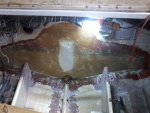IMO, pre-wrapping the plywood before installation accomplishes a few things:
Opportunity to 'practice' glassing and get resin mixing and consumption estimates for how each person works, as most have never done it. Working w plenty of room around and on a flat surface at waist level on a work bench/table
Isolates the components, stringers from the transom, bulkheads and etc and vice versa. So its possible to keep water compromised parts from damaging adjacent components.
Hopefully the edges of the plywood are as well sealed and protected from water intrusion as possible.
It provides 1 more layer of protection w 1 additional barrier in an imperfect process and practices by those that haven't done it before.
You can see all the results of your work. Dry spots, delamination of the glass from the plywood or other problems.
Once encapsulated, the parts and pieces are glassed and that should help prevent having dry placed plywood from wicking resin away from the joint, starving it of sufficient resin to bind tbe glass and plywood.
But, no, as far as I know, no manufacturer builds (or built) their boats that way.
Are the costs of time, money, effort and supplies worth it? Everyone must judge that for themselves.
I call myself lazy, but a better description is efficient, I hate extra steps that don't accomplish anything, I can't stand doing something twice when it can be done once and the the results are the same or better. Some people like tinkering, and if something makes them feel good, they do it whether it helps or not. But that ain't me.
1. It may be easier to get a little glass experience prior to jumping in the boat, but there are many opportunities to get this practice in other parts of the project.
2. The individual pieces of wood can be isolated just as easily when it's done in place.
3. You will be resin coating the wood in the exact same way, so everything will be sealed.
4. You won't be adding one more layer of glass, the same amount will be used either way.
5. You can see just as much when it's done at one time in the hull, if there are mistakes you will be fixing them either way. One of the biggest problems is people trying to apply one layer of glass at a time, it's actually much easier to do multiple layers at a time.
6. The wood will have been resin coated, so there won't be dry spots from resin being sucked into the plywood.
They don't do it in production because there are no real benefits in doing it that way, you just add a tremendous amount of time laying out the boards, glassing them, trimming and turning them over, glassing the other side and trimming it a again. Whatever time is spent doing all of this is wasted because you need to do all again inside the boat, just with one layer less of glass.
All the layers can be done at one time when in the boat, it's actually easier to do several layers of glass at one time than just one at a time, the results are typically much better too.
After saying that, if it makes someone feel better glassing the wood prior to installing it it's totally up to them, they can do it any way they please, but the reason isn't that it turns out better.























